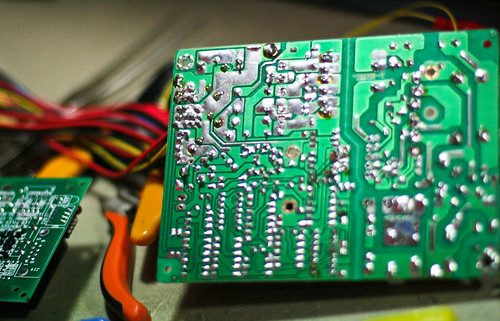Published in the element14 Journal, Vol. 2
Across the world, hackerspaces have begun popping up with increasing frequency over the last couple years. These physical locations are run by communities of individuals with common interests in areas such as art, science & technology. The mission of any hackerspace is to bring people together to collaborate on projects and educate each other. Members of a hackerspace community cover a broad terrain of disciplines, from artists to engineers, and students to professionals.
“We all need community!”, argues Mitch Altman, co-founder of the hackerspace in San Fransico, Noisebridge (http://www.noisebridge.net/), “It is sorely lacking in our modern world. But the need for community is in our DNA. [..] We can survive without community, but we can not thrive.”
In addition to the need for community, we have an inherent need to make. Our ability to create & use tools has been key to the survival our species.
“Just because we can now buy anything we want or need doesn't mean that we don't still have the need to express ourselves through making things”, Altman elaborates, “If we don't allow this expression, then some part of us is yearning for it, even if we don't know it.”
Photo by Anne Petersen
Hackerspaces satisfy these two very basic needs by providing a physical space in a which a community can grow around building projects. The power of this combination is evidenced by the rapid founding of hackerspaces around the globe. The hackerspace movement has spread to every continent other than Antarctica. The websitehttp://hackerspaces.org/ maps a full list spaces around the world. There are more than 250 active hackerspaces with over another 200 being built out or planned.
Photo by Kamil Krawczyk
The movement began primarily in Germany and Austria. Berlin-based hackerspace, c-base (http://www.c-base.org/), has been in operation for 15 years and is highly regarded as one of the original hackerspaces. As a mark of creativity, it has been designed with the theme that it is the remnants of space station buried under the city. In the summer of 2007, a group from the US, dubbed “Hackers on a Plane”, attended the Chaos Communication Camp in Germany. The trip included a tour of European hackerspaces like c-base, Metalab (http://metalab.at/) in Vienna and others.
Inspired by their journey, members of the group set out to found hackerspaces in their cities. Bre Pettis helped found NYC Resistor (http://www.nycresistor.com/) while Eric Michaud and Nick Farr got HacDC (http://hacdc.org/) off the ground in Washington, D.C. Mitch Altman followed by co-founding Noisebridge in San Fransisco. As a sign of a healthy community, some of the founders who lead these early spaces have been replaced by new members while moving on found new spaces. I'm a member of Chicago's hackerspace, Pumping Station: One (http://pumpingstationone.org/), which was founded by Michaud, after moving from the DC area, and others.
Photo by Anne Petersen
While hackerspaces are great community resources, their purpose may be at first misconstrued. Unfortunately, the news media & popular culture have co-opted the term hacker to describe those that commit criminal activity using computers & technology. However, the genesis of the term was at the MIT Tech Model Railroad Club in 1960s where the first hackers built electronics for power & signaling. When the use of computers became more widespread, the term hacker grew to describe an expert programmer. In modern context, the term can be used to describe anyone who is an expert or enthusiast of any discipline. True hackers are creators, inventors & tinkerers. They are driven to understand how a system works and improve upon it. Education and sharing knowledge openly are core values of the hacker culture.
Photo by Anne Petersen
The activities of a hackerspace are well encapsulated by Make magazine (http://www.makezine.com/). It's Do-It-Yourself (DIY) ethic & project-oriented theme sums up what a hackerspace is all about. A hackerspace provides the tools & infrastructure to support a wide-range of disciplines including programming, electronics, physics, chemistry, mathematics, metal & wood working, music, photography, security, robotics along with many forms of art & crafting. Workshops & classes are routinely held at hackerspaces to educate members and the local community on the skills required to practice those disciplines. The real magic happens when individuals start crossing between disciplines in unexpected and wonderful ways.
Photo by Anne Petersen
Coinciding with the Hackerspace movement and the publication of Make, advances in technology have opened up the world of electronics to new audiences. Open source hardware platforms like Arduino (http://www.arduino.cc/) have softened the learning curve for creating complex electronic projects. From artists to engineers, new ideas can be rapidly prototyped thanks to an easy-to-use programming environment and standard form factor that allows for modules, also called “shields”, providing different functionality to be stacked on.
Photo by Anne Petersen
A further testament to the power of DIY open source hardware is MakerBot Industries (http://makerbot.com/) and its affordable 3-D printer, the Cupcake CNC. Pricey commercial 3-D printers have been around for years, but the development of the open DIY technology brings the power desktop manufacturing to the masses. MakerBot grew out of the work NYC Resistor members, including Pettis, were doing on RepRap, an existing open DIY 3-D printer project (http://reprap.org/). Thanks to power of open source, the NYC Resistor hackers were able to refine the design into a simpler, ready-to-assemble kit that has lowered the learning curve. At my hackerspace, Pumping Station: One, I've had the joy to behold the machine in action. It's amazing ability to bring any 3-D design into physical reality has the promise to revolutionize prototyping and even manufacturing.
Walk into any hackerspace and you'll find an abundance of creative projects across many disciplines and forms of art. NYC Resistor member, Ranjit Bhatnagar (http://moonmilk.com/), created a MIDI robotic toy player piano after salvaging metal chimes & hammers from 50 year old toy piano, damaged during shipping, and adding an array of 30 cheap solenoids under MIDI control. Sean Auriti at fellow New York hackerspace, Alpha One Labs in Brooklyn (http://alphaonelabs.com/), is building an affordable DIY telepresense robot and prototyping a new wing for their flying saucer.
At i3 Detroit (http://www.i3detroit.com/), Eric Merrill has custom built a fast & maneuverable 4-rotor quadcopter controlled by Arduino brains. Another i3 member, Matt Switlik, has created an Arduino-powered foam dart shooting range with four pop-up targets and a skeeball machine with scoring, ball return and safety equipment for the small children . These promise to please the crowd at Maker Faire Detroit, an extravaganza of amazing DIY projects on the July 31st weekend (http://makerfaire.com/). Amanda Sari Perez & Josh Valdes from All Hands Active, or AHA!, (http://allhandsactive.com/) down the road in Ann Arbor, MI, are participating in a collaborative project, coordinated via the net, to build a giant maze that will be erected at Burning Man, an annual week-long event in the Nevada desert that blends art & technology.
Pumping Station: One president Sacha De'Angeli (http://chemhacker.com/), applies his background in chemical engineering to explore the cutting edge of chemistry. De'Angeli has been developing and sharing DIY techniques to fabricate magnetic nano particles & produce ferrofluids. Also at the Chicago hackerspace, founding member Eli Skipp (http://eliskipp.com/) melds hardware hacking and crafting into amazing projects like the Fabric Light Bright constructed out of LEDs sewn into conductive fabric in any pattern of your choosing.
Noisebridge in San Francisco even has a space program called Spacebridge. They have successfully launched into near space a weather balloon decked out cameras to record the ascent and snap shots of the curvature of the Earth at its apex. The team then tracks the craft via on-board GPS and radio system. Recovery can prove to be a challenging task involving rough terrain.
I discovered and promptly joined my local hackerspace earlier this year. In the short time since, I've seen too many amazing projects to count and met an abundance of excellent people from the world-wide hackerspace community. No matter what your discipline - if you want get inspired and make cool things, then find your local hackerspace at: http://hackerspaces.org/. If one doesn't exist yet, then join the movement and build one!
Drew Fustini is a life-long software developer, aspiring hardware hacker & proud member of Chicago's Hackerspace, Pumping Station: One (http://pumpingstationone.org). Follow him at http://twitter.com/pdp7 and find insights into the hackerspace community and DIY scene on his element14 blog: http://www.element-14.com/community/blogs/pdp7









